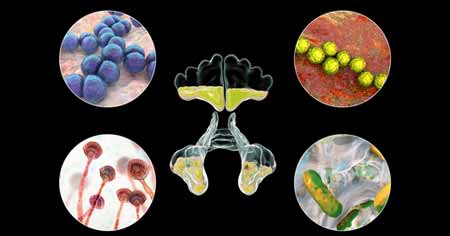What Is Pneumonia?
Pneumonia occurs when the lungs’ air sacs and small airways fill with liquid and cannot function properly. When gas exchange is impeded, the body cannot take in oxygen as it normally would. Oxygen is vital to the body’s cells, where it is needed for aerobic respiration; the breakdown of glucose to obtain energy for cellular work.
Causes of Pneumonia

Pneumonia can have many different causes: viral, bacterial, fungal or, in the case of aspiration pneumonia, may result from the inhalation of substances such as caustic chemicals, food or vomit.
Endemic Fungal Pneumonia
Fungal pneumonia is an infection in the lungs caused by any one or a combination of endemic and opportunistic fungi. Unlike opportunistic fungi, endemic fungal pathogens are able to cause infection in both healthy and immunocompromised individuals. The most frequently encountered endemic fungi are Cryptococcus, Histoplasma, Blastomyces.
Pathophysiology
Infection occurs following the inhalation of spores, or by the reactivation of a latent infection. Dissemination through the circulatory system can occur, especially in the immunocompromised.
Occurrence in U.S.
Endemic fungi are prevalent in the Mississippi River Valley, Ohio River Valley (H. capsulatum and B. dermatitidis), and the southwestern United States (C. immitis).
Diagnosis & Treatment
Usually diagnosis is made by identifying the fungus in a sputum sample, performing a blood or urine test to detect the organism, or by examining the blood for certain antibodies. Treatment typically consists of taking an antifungal drug.
Morbidity and Mortality

The endemic fungal pneumonias are generally self-limited in healthy people. C. immitis is considered to be the most virulent; yet, 90% of patients recover without treatment. However, in patients with AIDS, the mortality rate is as high as 70%.
Types of Endemic Fungal Pneumonia
Histoplasmosis
Organism: Histoplasma capsulatum
Histoplasmosis infection may cause either acute or chronic pneumonia. In rare cases the infection spreads to other areas of the body, such as the bone marrow, liver, spleen, and digestive tract. The spread of the infection most often occurs in people who have immune system disorders, see more.
Many who inhale the spores of this fungus never experience any symptoms, and may not even learn that they have been exposed unless they have a chest x-ray revealing a nodule or enlarged lymph nodes. Others may have symptoms including cough, fever, muscle aches, and chest pain.
Coccidioidomycosis
Organism: Coccidioides immitis
Coccidioidomycosis, also called Valley Fever, is usually a self-limited respiratory infection, and after being inhaled, the fungus may cause no symptoms.
More virulent Coccidioides may cause either acute or chronic pneumonia. In some cases, the infection spreads beyond the respiratory system—typically to the skin, bones, joints, and tissues covering the brain. This complication is more common people who have AIDS or other immune system disorders.
Blastomycosis
Organism: Blastomyces dermatitidis

After being inhaled, the fungus causes infection primarily in the lungs, typically producing no symptoms. Subclinical (asymptomatic) cases of Blastomycosis occur in at least 50% of infected individuals.
However, this infection is highly variable, and in rare cases, Blastomycosis may result in a chronic lung infection that lasts for months. The disease may spread to other parts of the body, especially the skin, bones, joints, and prostate gland.


